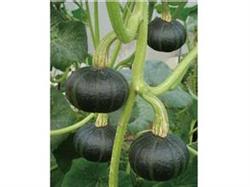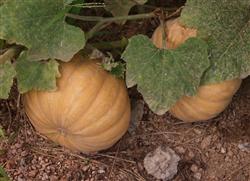Key points of cultivation techniques of small pumpkin in spring

1. Suitable sowing time: spring sowing in greenhouse from mid-January to early February, seedling age 20-25 days; open field cultivation in small arch shed, sowing in mid-and late February, seedling age 20-25 days, planted in small arch shed in early and middle March. Second, seed treatment and sowing: pumpkin seeds soaked in water for 3-4 hours, then 50% carbendazim 500 times solution for 2 hours, rinse clean, 25-30 ℃ to accelerate germination for 24-48 hours, sow in the heating seedbed. 3. Seedling stage management: the temperature is 25-30 ℃ in daytime and 15-20 ℃ at night before emergence, 20-25 ℃ in daytime and 15 ℃ at night after emergence, and colonized when 3-4 leaves are unfolded. 7-10 days before planting, the seedling bowl was moved once, and the squatting seedling enhanced the stress resistance. The seedlings are protected against high temperature, the greenhouse temperature is below 30 ℃, and the seedlings are protected from burning in sunny days. Ventilate and reduce humidity in cloudy and rainy days to keep the seedling bed dry and wet. Without topdressing at seedling stage, combined with the mixture of 500 times of carbendazim or chlorothalonil and compound high quality foliar fertilizer, it was sprayed once a week. Fourth, land preparation and planting: stand cultivation border width of 80-100 cm, plant spacing of 30-35 cm, 1 row of each plant. Small arch shed open field cultivation one-way climbing border width of 3 meters. Apply 80 kg of bio-organic compound fertilizer or 1000-2000 kg of mature organic fertilizer per mu. Plant 800-1000 plants per mu, protect the roots and transplant, and irrigate the roots immediately after planting. 5. Field management: 1. Fertilizer and water: pumpkin has strong fertilizer absorption, nitrogen fertilizer should be controlled in the early stage, and full topdressing should be applied during fruit development and expansion period. For the first time, 5-6 kg of ternary compound fertilizer was applied per mu 10-14 days after planting. Cover the soil and water after application. The second time in the fruit expansion period, 20-25 kg of ternary compound fertilizer and 5 kg of potassium fertilizer were applied per mu, and the soil was watered after application. In the future, fertilizer will be applied according to the plant growth and fruit setting. 2. Tie the vine to set up the frame: tie the vine, draw the vine on the shelf, make full use of the space, improve the light, be beneficial to close planting and increase the yield. Climbing cultivation should build a low frame, lead the vine on the shelf, so that the fruit can be lifted, fully see the light, and color evenly. 3. Flowering and fruiting habits and pruning methods: small pumpkins are monoecious, and female flowers occur earlier on the main vine. Single vine pruning in the greenhouse, 3-4 female flowers above 10 nodes began to set fruit, 3-4 female flowers were pollinated continuously, and 2-3 fruits were left per plant. Small arch shed open ground climbing cultivation, double or multi-vine pruning, 4-5 fruit per plant. 4. Flower and fruit protection: in early spring, low temperature season is often due to excessive fertilizer and water before flowering, excessive vegetative growth, insufficient nutrition of flowers and fruits, overcast and rain during flowering period affect pollination or female flowers bloom early, no male flowers are pollinated, resulting in falling flowers and fruits. Therefore, artificial pollination should be carried out from 8 am to 10:00 in the morning during flowering. It can also be treated with Baoguoning No. 2 800x solution or 2.2% anti-falling hormone 500x or 20% phenylacetic acid 1200 times, and the flowers blooming on the same day are sprayed on the stigma to promote the fruit. 5. Pest control: powdery mildew was sprayed with 12.5% nitrilazole 2000-3000 times. Fusarium wilt is daubed on the stem in a paste with 10 grams of manganese zinc and 70% alcohol. White whitefly is treated with fipronil or avermectin, and Liriomyza huidobrensis is controlled with Qianke. 6. Harvest: the first melon was collected about 30 days after spring pollination to promote the full expansion of the second and third fruits and increase the yield.
- Prev

Spring cultivation techniques of Mini Pumpkin
Mini pumpkin is a hybrid bred by Suzhou vegetable Research Institute. It has medium growth potential, dark green leaves, 2.0-2.5 m long stem, short internodes and medium branches. Both main and lateral vines can bear melons. Strong adaptability, fast growth, high yield, small size, golden color, good taste, suitable for long distance.
- Next

How to make a pumpkin in spring
Spring open field cultivation techniques 1, sowing and seedling: the pumpkin varieties introduced above belong to the western pumpkin type, spring cultivation is suitable for early sowing, sowing date can be calculated according to the planting period. Such as Jianghuai, can be planted in late April, with seedling age of 30 days, should be planted in late March. If you want to go to a certain place...
Related
- Where is it suitable to grow horseradish in China? it is expected to see the middle altitude horseradish in Alishan.
- How to prevent tomato virus disease reasonably? (Control methods included)
- Many people like to plant towel gourd on the balcony. What are the main points of this method and management?
- What crops can chili peppers be mixed with?
- Fertilization techniques and matters needing attention in Tomato
- What are the grafting techniques for peach seedlings in spring?
- Harm and control methods of root swelling disease of Chinese cabbage
- What are the pests of sweet potatoes? How to prevent and cure it?
- Symptoms, causes and Control methods of navel Rot in Tomato
- The cause of "Cucumber rotten bibcock" in Farmers' planting Cucumber and its Control Plan

